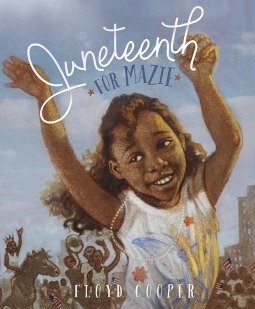Mama's Nightingale: A Story of Immigration and Separation by Edwidge Danticat
Our students had a lot of questions about refugee status after we read this book. We also talked about how a quick and successful resolution to immigration challenges is very unusual. You can find more ideas for relevant picture books here (I’m also a big fan of The Journey by Francesca Sanna). Students may have different levels of familiarity about immigration status and varied understanding (or lack thereof) of what the word “refugee” means, so be prepared to teach into this.
You can find more read aloud ideas here: Children's Picture Books: Stories about Characters of Haitian Ethnicity | Diverse BookFinder and here: Teaching About Haiti - Social Justice Books.
My students were also intrigued to learn more about Haitian Creole as it wasn’t a language they had heard of before and they had a lot of questions about its connections with French. I always love teaching students about food (and cooking and eating, if possible!), and music is a great connection to the language(s), history, and culture of a place. Of course, the best way to learn about a place is to actually speak to people who have connections there. We also love looking at photographs through Google Earth so students can dispel any misconceptions about what certain areas of the world have or do not have.
As I mentioned earlier, our trip to the Dominican Republic made me wish I had learned about the Haitian Revolution much earlier. Haiti was the first modern state to abolish slavery and the first state in the world to be formed from a successful revolt of enslaved black peoples. Why isn’t this history featured more (or at all) in (American) schools as an example of resistance and revolution? It is an important counter narrative to slavery in the United States (Thomas Jefferson, who was the US president at the time, was very aware of this). 'The Greatest Heist In History': How Haiti Was Forced To Pay Reparations For Freedom : Planet Money : NPR details what happened after Haiti became an independent state, in particular France and the USA’s attempts to delegitimize and destabilize the new nation.
This story, Haiti faces disasters and chaos. Its people are most likely to be denied U.S. asylum, from 2021 could help students see how history affects the present and why and how past actions and policies continue to matter and leave their mark today.
Teaching students about slavery is challenging for so many reasons, but learning about the Haitian Revolution could help students understand the many different systems at play and how slavery wasn’t an isolated event happening in the United States. Students could analyze economic, political, social, and geographic factors and ask questions and formulate theories about who was trying (and continues to try) to control narratives and perception and why we still only learn certain parts of history and hear certain perspectives. Looking at two timelines side by side (US slavery and the events in Haiti) or looking at primary sources like photographs would be an accessible and age appropriate way for elementary school students to start this rigorous and engaging work.
We know it is May and you don’t have time for anything, let alone creating and teaching an in depth history and analysis unit, but maybe this is something to think about for next year or a future opportunity. Acknowledging Haitian Heritage Month and giving your students space to think about what they might want to learn could be a great morning activity and read alouds always help calm students down and dissipate some of that end of the school year energy. However you choose to recognize this month, we wish you a peaceful and calm May and happy Haitian Heritage Month!



